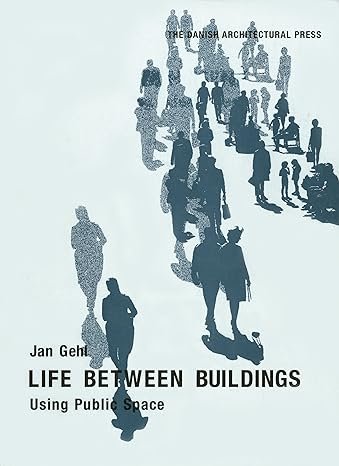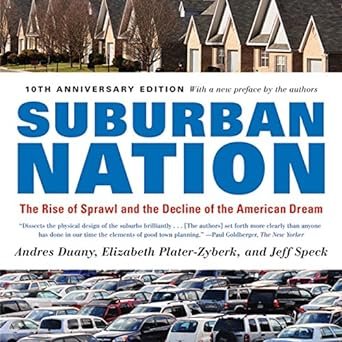
Learn with us.
In the hopes of empowering our community with the tools to drive meaningful change, we’re sharing educational resources with you, including the history of Fondren, as well as insight from visionaries, leaders, and authorities in the areas of community planning, urban design, and placemaking. Check out the works of these folks to find innovative thinking and aspirational precedents that we can follow, and let us know what you think makes sense for Fondren wihtin our unique historical and cultural landscape.
Book Club
Some of our favorite books on some of our favorite topics. Links for purchase are provided on each book for online buying with most of these products available through our friends at Lemuria.
The Death and Life of Great American Cities has, since its first publication in 1961, become the standard against which all city planning endeavors in that field are measured. Charming, compassionate, beautiful, and bracingly indignant, Jane Jacobs's monumental work provides an essential framework for assessing and understanding the vitality of all cities and neighborhoods.
By helping us better understand the larger public life of cities, Life between Buildings can only move us toward more lively and healthy public places. Buy this book, find a comfortable place to sit in a public park or plaza, begin reading, look around. You will be surprised at how you will start to see (and design) the world differently.
There is a growing movement in America to put an end to suburban sprawl and to replace the automobile-based settlement patterns of the past fifty years with more traditional planning principles. Suburban Nation is a lively, thorough, critical lament, and an entertaining lesson on the distinctions between between these two planning ideologies and the drastically different places they produce.
Jeff Speck has dedicated his career to determining what makes cities thrive. And he has boiled it down to one key factor: walkability. But in the typical American city, the car is still king, and downtown is a place that's easy to drive to but often not worth arriving at. In this book, Speck reveals the invisible workings of the city, how simple decisions have cascading effects, and how we can all make the right choices for our communities.
Today we see sprawling cities that are better suited to cars than people. Donald Shoup contends in The High Cost of Free Parking that the demand for parking by drivers is unfortunately eating away at their very quality of life, and he proposes new ways for cities to regulate parking so that Americans can stop paying for free parking's hidden costs.
Rich with new insights from psychology, neuroscience, and Charles Montgomery’s own urban experiments, Happy City reveals how our cities can shape our thoughts as well as our behavior. The message is as surprising as it is by retrofitting cities and our own lives for happiness, we can tackle the urgent challenges of our age. The happy city can save the world-- and all of us can help build it.
Brain Trusts
Some of our favorites organizations and sites thinking about the ways to improve cities, towns, and neighborhoods. Check not only their web content but their socials for invaluable insight.
Strong Towns gives citizens the knowledge and tools to start making our places better today.
Project for Public Spaces champions placemaking to create community-powered public spaces around the world.
Better Block educates and empowers communities to reshape spaces that promote the growth of vibrant neighborhoods.
Missing Middle highlights a time-proven and beloved way to provide housing choice in sustainable, walkable places.
The Congress for the New Urbanism helps create socially just, economically robust, resilient, and people centered places.
NACTO is an association cities and transit agencies exchanging insights and practices to address transportation issues.
The History of Fondren
We’ve always been a little crazy.
In In 1817, Mississippi attained statehood, prompting the state legislature to form a three-member commission in 1821 to designate a suitable location for the new capital. The commission selected an inland site in Hinds County, strategically positioned near the state’s center, and named it Jackson. By the 1830s, a thoroughfare extending north from the burgeoning state capital connected to Canton, the county seat of Madison, earning the name Canton Road, now known as Old Canton Road. Approximately three miles north of Jackson, a secondary route veered westward towards Tougaloo Plantation, initially dubbed Tougaloo Plantation Road but later incorporated into North State Street. Fondren, as it is known today, eventually emerged and expanded from this significant junction.
In 1833, the area was part of a 5,000-acre plantation owned by the Garland family, which spread from present day Northside Drive and State Street east to the Pearl River and Lakeland Drive. Around 1840, William Garland constructed a two-room cottage for his family, which stands today as The Cedars and serves as Jackson’s oldest surviving residential structure. Portions of their land just south of the intersection were sold to the State of Mississippi in 1848 for the construction of a large neo-classical mental health hospital, known at the time as the “Lunatic Asylum.” This facility addressed mental health needs for the entire state of Mississippi and grew significantly over the subsequent decades, becoming a substantial institution with an extensive campus and staff.
Following the Civil War in 1865, the remaining portions of the Garland plantation were destroyed, and the property was divided during the Reconstruction Era. Isham Cade, a Black entrepreneur from Carroll County and former enslaved person, acquired a substantial portion of land around the fork in the two roads. His vision was to subdivide the land and offer it for sale to other formerly enslaved individuals looking for places to build their own homes. He divided the land into parcels, had the area surveyed, and began selling lots, leading to the early growth of a Black community centered around a collection of houses along what was known as “Cade’s Alley,” now Duling Avenue. The street included sites for a church and school, both of which were built on land that Isham Cade donated and would become important community anchors.
Building on this momentum and capitalizing on the intersection’s strategic location, numerous small businesses sprang up, catering to the needs of the community, the ever-growing hospital, and the increasing number of north-south travelers. The medical complex would emerge as the largest employer in the state and its growing functions would transform the local landscape. As part of this evolution, a trolley line was established, conveniently connecting downtown Jackson to the hospital and supporting in-town transportation. To facilitate large-scale deliveries to the hospital, the Illinois Central Railroad constructed a spur line, which also provided community members with convenient access to incoming supplies and greater connection to regional and national destinations. This convergence of various opportunities led to the neighborhood’s development from a residential area to a bustling village, inviting a new diversity of people and businesses. The train station, named “Asylum Switch,” played a pivotal role in cementing the name “‘Sylum Heights” for the growing community.
The first Fondren in Mississippi, a pioneer named Richard Fondren, arrived in 1893, establishing a family farm six miles north of Jackson. Two of his sons, Edward and David Fondren, ventured a few miles south in the same year and established themselves in the region now bearing their family name. David built a wood-frame grocery store between Old Canton Road and North State Street, known as David Fondren’s General Merchandise and Fancy Grocery, becoming a centerpiece of community life. In 1894, a post office was incorporated into the general store, a common practice of the era, which also designated David Fondren as the postmaster. The establishment of a post office necessitated a standardized name for the town for postal communications. Residents petitioned the U.S. Postal Service to designate the station as ‘Fondren,’ a name the community still bears today. The present day post office building on Fondren Place is just north of the original store site.
By the early 20th century, Fondren was a well-established community with commercial ventures such as restaurants, drugstores, and hardware stores. Jackson, growing to the south, annexed the Fondren area in 1925, marking the first time a developed community was included in a Jackson annexation. By 1928, the growing neighborhood required its own school, leading to the construction of Duling Elementary, named in honor of Lorena Duling, a revered teacher within the Jackson school system. It opened with five teachers and 36 enrolled students.
In 1935, a new state mental hospital was constructed fifteen miles to the south of Jackson at Whitfield, and most of the old asylum structures were demolished. The Fondren community, now well established and racially diverse, was able to continue without the original organizing focus of the hospital, but the demolition would make the way for construction of the four Fondren area hospitals over the subsequent decades, forming the medical district that that occupies the site today.
Riding the movie theater boom of the era and welcoming much-needed entertainment options to Fondren, The Pix Theater, now known as the Capri, was built in 1939. It was the first Jackson theater to locate outside of the downtown area and featured the innovative Art Deco style which would ultimately help to influence a number of similar designs in the area. The theater was also the first in Jackson to showcase wall-to-wall drapery, Xenon lights, and rocking chairs.
In the 1940s, Fondren underwent significant transformations following the conclusion of World War II. The post-war building surge, economic prosperity, and a substantial uptick in car ownership rendered obsolete the once necessary small lots near the trolley line. This shift allowed for more expansive estate-sized planning, exhibited by the formation of neighborhoods like Woodland Hills. Reflecting these changing dynamics, the Morgan Center, now known as the Woodland Hills Shopping Center, debuted in 1946, including Jitney Jungle and Brent’s Drugs. As Jackson’s first “shopping center,” it embraced a novel concept that accommodated the new car culture, situating retail stores behind surface-level parking lots for the first time. The architectural design of the complex embraced the Streamline Moderne style, a later iteration of Art Deco characterized by the curving forms and horizontal lines of the ocean liners and trains of the time. War Veterans Memorial Stadium opened in 1950 with a seating capacity of 21,000. Mississippi Veterans Memorial Stadium, as we know it today, would undergo many expansions before it would reach its present-day size and capacity. In the late 1940’s and early 1950’s, post-war growth significantly contributed to the expansion of new housing options and notably increased the Fondren population.
Jackson’s first suburban “high-rise” office building, the Dale Building, was erected in Fondren in 1956, where the current Fondren Corner development exists. Additional shopping, banks, gas stations, barber shops, restaurants, and churches were added to the mix. The neighborhood continued to be quite racially diverse until the late 1950’s, when rising property values would slowly push some of the Black residents out of the area.
By the 1980s, Fondren experienced a decline as residents moved to suburban communities, leading to a reduction in owner-occupied housing. In 1996, a group of like-minded local business owners came together to plan for the neighborhood through different organizations and events. These efforts continued and expanded over the years, culminating in the official formation of the Fondren Renaissance Foundation (FRF) in 2002. The FRF focused on rehabilitating and reselling rental houses and instituted the state’s first urban main street program. In 2014, the “Downtown Fondren Historic District” received official recognition by being named to the National Register of Historic Places.
Today, Fondren stands as a thriving and beloved cultural center within Jackson. While David Fondren’s grocery store closed its doors in 1953, the Fondren community, continues to bear his name, paying homage to one of its first commercial tenants and a man fondly remembered as a community leader who ardently supported Fondren. The success of the district also owes much to Isham Cade, who played a key role in its development. With his hands-on approach, Cade passionately believed in constructing a neighborhood for his community, embodying the American dream and a classic entrepreneurial spirit. These two exceptional individuals, driven by an optimistic and steadfast commitment to community as well as a desire to leave a legacy for both Black & White residents alike, creatively shaped the neighborhood’s identity and culture, establishing the enduring values that make Fondren what it is today.
Illustration of Isham Cade
Postcard showing the Mississippi Lunatic Asylum
A young David Fondren
The first Fondren Grocery located on present day Fondren Place and showcasing a small "Fondren, MISS" sign, circa 1925
The second Fondren Grocery located on State Street
Marion Fondren working the register and phone at Fondren Grocery
An older David Fondren
Early years on "The Strip"
A newspaper article at the time of David Fondren's death, lovingly noting Fondren as an "unusual man"
The 1946 blueprints of Jitney Jungle showing its Art Deco flair
A postcard of Veterans Memorial Stadium
A 1956 newspaper article, noting Fondren's "unusual" character
The Pix Theater, 1960
How to Make Cities that People Love
On February 15, we hosted a virtual lecture about the fascinating history of city and neighborhood design in America, and what we principles we can learn from it in order to shape the future Fondren into a more well-rounded and beloved community. It’s an in-depth discussion for those who want it, so grab some popcorn and get comfortable!
























